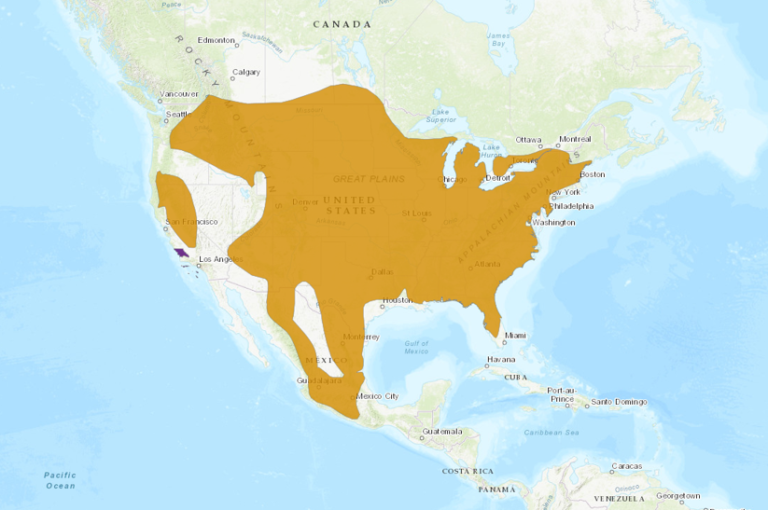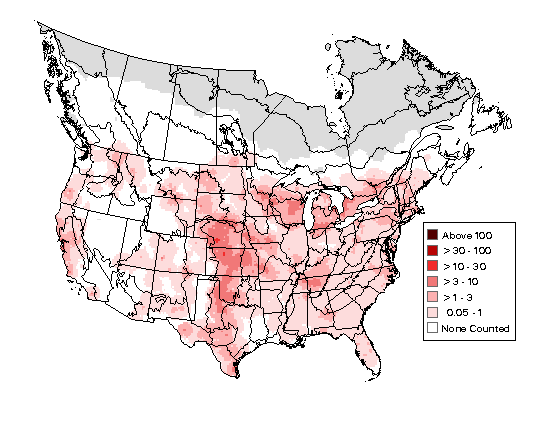Birdfinding.info ⇒ Although extensive hunting in the 1800s and early 1900s has rendered it uncommon and local across most of its range, the Wild Turkey has become a conservation success story and is common in much of the U.S. and southern Canada. Especially common in the Great Plains from South Dakota to Texas, around the Great Lakes, southern New England, the mid-South, and in oak-dominated woodlands of the western states. (See Breeding Bird Survey Abundance Map in Notes, below.)
Wild Turkey
Meleagris gallopavo
Temperate North America, in woodlands and semiopen habitats.
Occurs nearly throughout the contiguous U.S., north into the border regions of Canada from British Columbia to New Brunswick, and south in Mexico locally to Michoacán and the State of Mexico.
Reintroduction and game management programs have resulted in widespread population increases and a general range expansion—such that it now occurs in some parts of the western U.S. and Canada where it was not known to be native.
Introduced populations are established in Hawaii (from Molokai to the Big Island), New Caledonia, New Zealand (North and South Islands), and locally in southern Australia (mainly on islands in Bass Strait and Kangaroo Island.
Identification
A familiar species whose basic appearance is known to most North Americans and much of the global population elsewhere.
Large in most dimensions: long-legged, long-necked, long-tailed, and heavy bodied.
It is among the world’s heaviest birds: males weigh up to about 11 kg and females up to about 5 kg (but note that domestic turkeys can be significantly heavier).
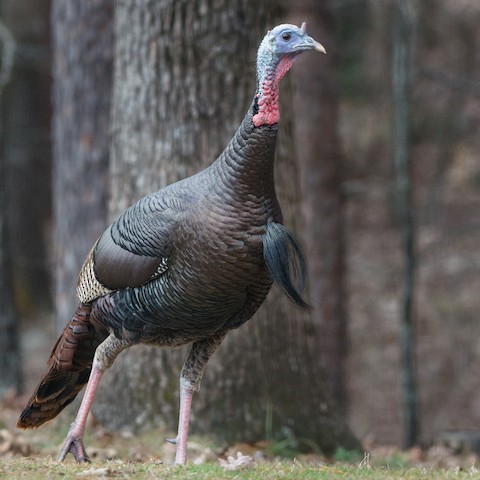
Wild Turkey, male. (Big Rock, Arkansas; December 3, 2018.) © Susan Williamson
The plumage is brown overall, often with a greenish or coppery iridescence.
The wings are boldly barred, and the tail is finely barred rusty-brown and black, with a pale terminal band, which varies from whitish to rusty, and a black subterminal band.
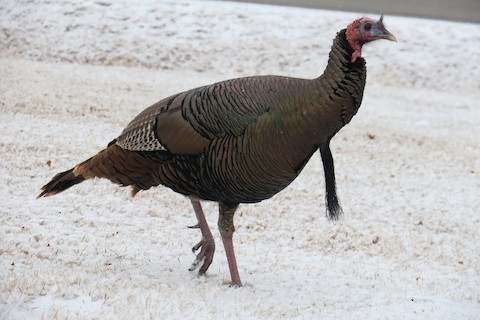
Wild Turkey, male. (Wichita Mountains Wildlife Refuge, Comanche County, Oklahoma; December 27, 2017.) © Rishi Palit
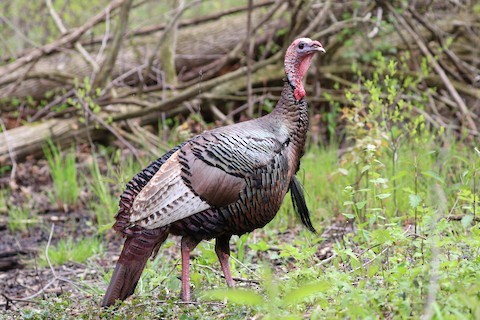
Wild Turkey, male. (Point Pelee National Park, Ontario; May 12, 2016.) © Aaron Marshall
The head and upper neck are unfeathered, with a raw, “plucked” texture, and wart-like bumps, usually pinkish overall with gray or blue tones around the face, but can also be mostly gray or blue.
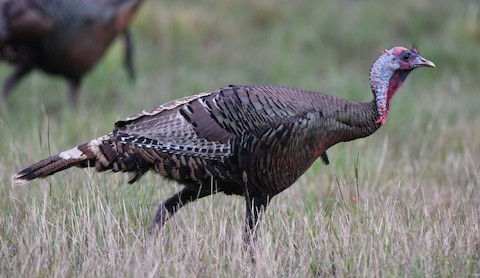
Wild Turkey. (Choke Canyon State Park, Calliham, Texas; March 3, 2017.) © Mike Charest
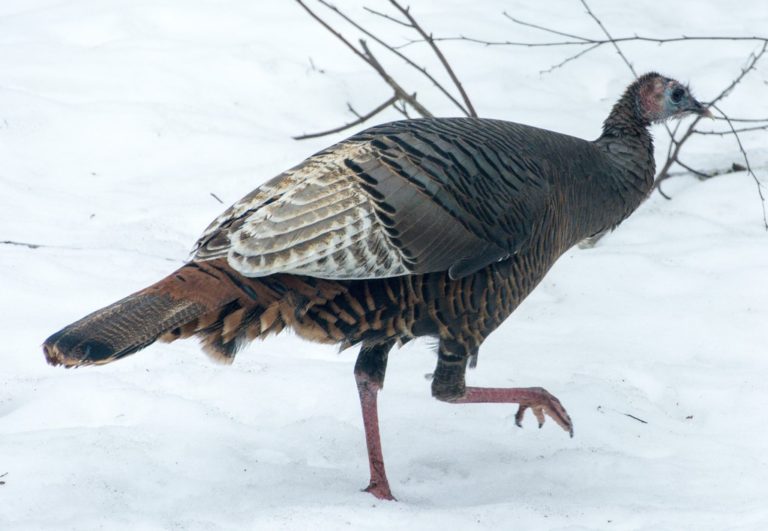
Wild Turkey. (Potsdam, New York; March 30, 2015.) © Omar Stradella
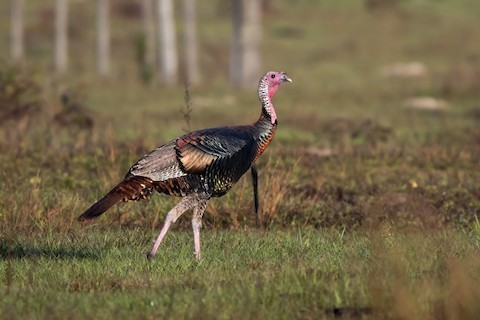
Wild Turkey, male. (Brooker Creek Preserve, Pinellas County, Florida; December 1, 2019.) © Melissa James

Wild Turkey, male. (Point Pelee National Park, Ontario; May 12, 2016.) © Skip Russell

Wild Turkey, male. (Plum Island, Massachusetts; June 3, 2017.) © Matt Kelly
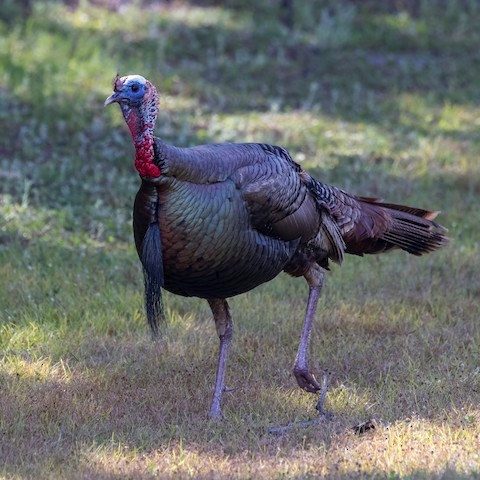
Wild Turkey, male. (Gator Hole Preserve, Estero, Florida; March 10, 2018.) © Peter Hawrylyshyn
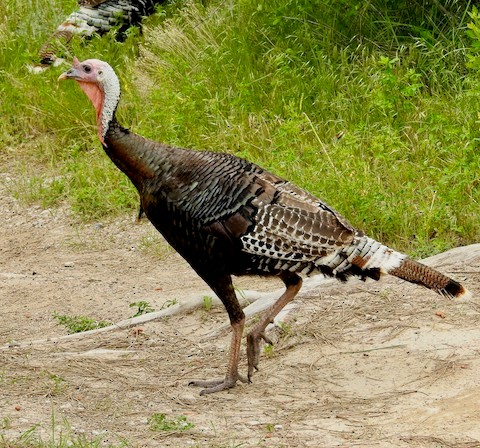
Wild Turkey. (Wildcat Hills State Recreation Area, Nebraska; June 16, 2019.) © Van Remsen
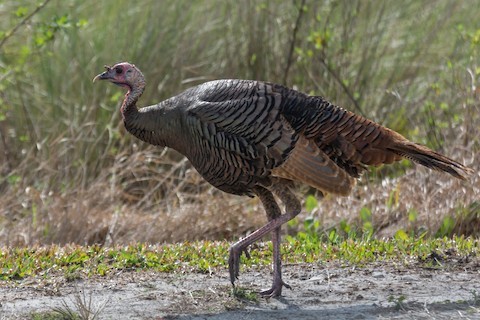
Wild Turkey, female. (Canaveral National Seashore, Florida; March 5, 2017.) © Camille Merrell
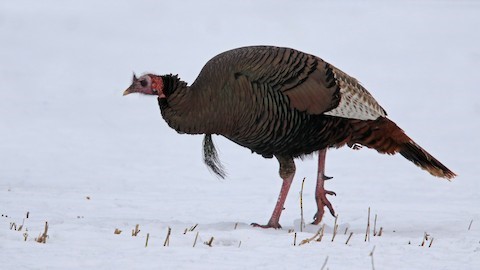
Wild Turkey, male. (Drummondville, Quebec; January 23, 2017.) © Daniel Jauvin
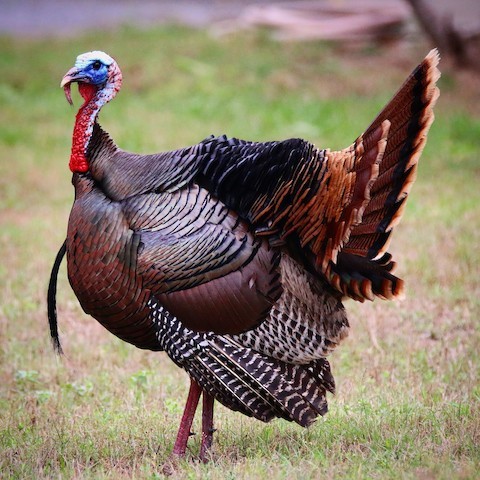
Wild Turkey, male displaying. (King Ranch – Norias Division, Texas; April 5, 2018.) © Jeff Kietzmann
The sexes are similar except that males are somewhat larger, have a tuft of elongated feathers on the chest, and tend to show more vivid blue and red on the head and neck.
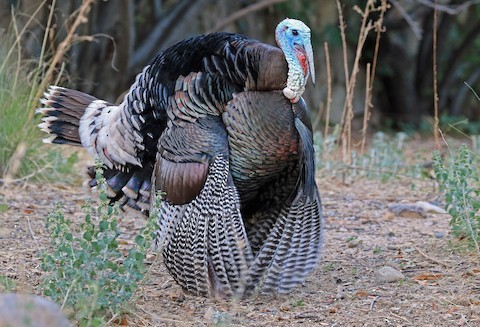
Wild Turkey, male beginning display. (Madera Canyon, Arizona; April 26, 2016.) © Phillip Edwards

Wild Turkey, male displaying. (Madera Canyon, Arizona; April 26, 2016.) © Phillip Edwards
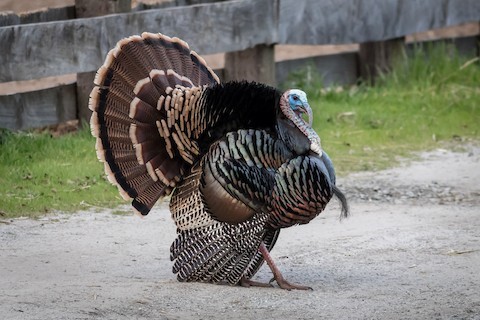
Wild Turkey, male displaying. (Chews Ridge, Pfeiffer Big Sur State Park, California; March 31, 2018.) © Carole Rose
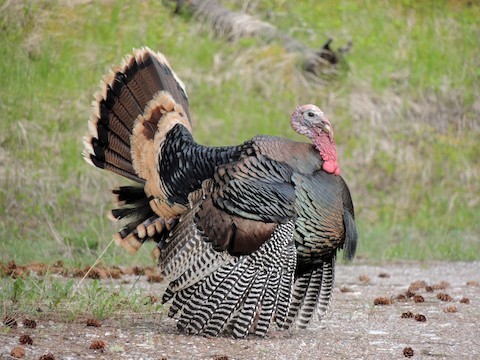
Wild Turkey, male displaying. (Radium Golf Course, East Kootenay, British Columbia; May 11, 2017.) © Brian McKenney
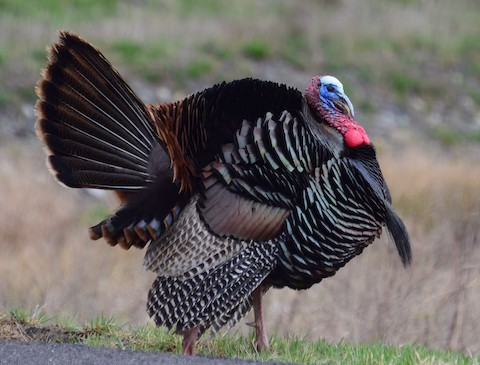
Wild Turkey, male displaying. (Imperial Grasslands, Allegheny County, Pennsylvania; March 26, 2016.) © Todd Hooe

Wild Turkey, male displaying. (Jasper Ridge, San Mateo County, California; March 25, 2018.) © Brian Sullivan
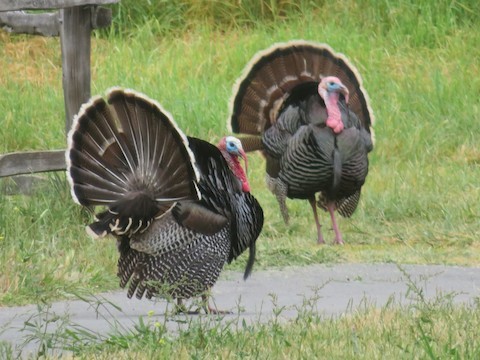
Wild Turkey, males displaying. (Ed Levin Country Park, Milpitas, California; May 14, 2019.) © Tracy Pham
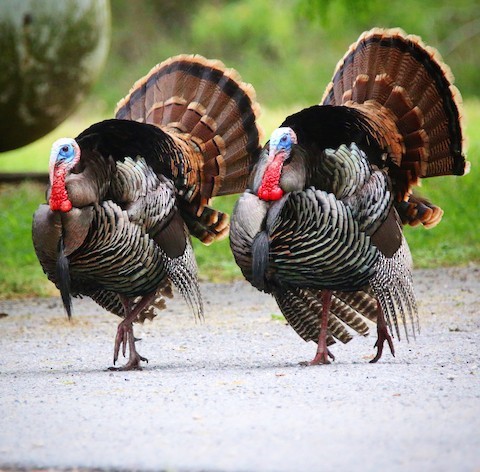
Wild Turkey, males displaying. (King Ranch – Norias Division, Texas; April 5, 2018.) © Jeff Kietzmann

Wild Turkey, male displaying. (East Whitetail Canyon, Hilltop, Arizona; April 19, 2018.) © Victor Stoll

Wild Turkey, males displaying. (Stony Creek Metropark, Macomb County, Michigan; April 1, 2020.) © Andrew Simon
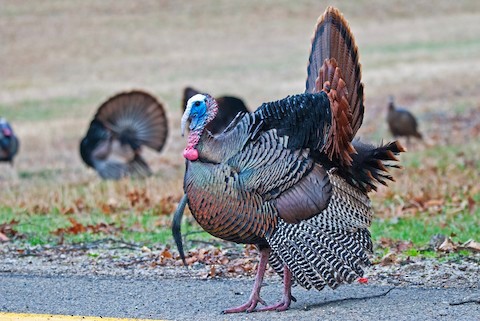
Wild Turkey, male displaying. (Stony Creek Metropark, Macomb County, Michigan; April 1, 2020.) © Andrew Simon

Wild Turkey, male displaying. (Parker River National Wildlife Refuge, Massachusetts; April 1, 2016.) © Marjorie Watson
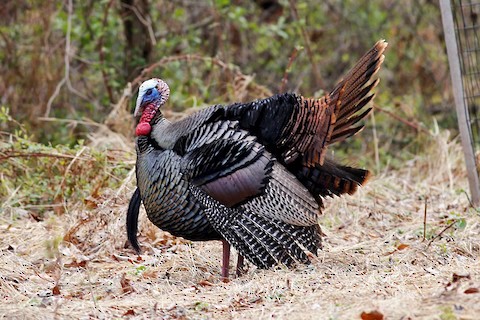
Wild Turkey, male displaying. (Pennypack Ecological Restoration Trust, Montgomery County, Pennsylvania; April 12, 2016.) © William Keim

Wild Turkey, male displaying. (Pennypack Ecological Restoration Trust, Montgomery County, Pennsylvania; April 12, 2016.) © William Keim
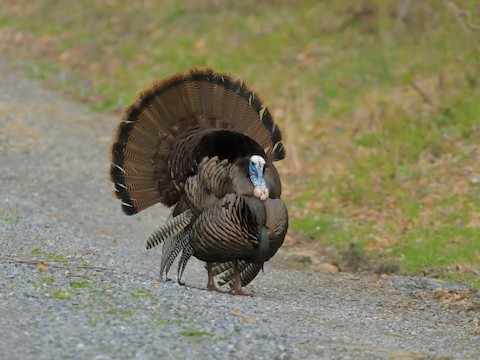
Wild Turkey, male displaying. (Bedford, Virginia; March 29, 2020.) © Bob Epperson
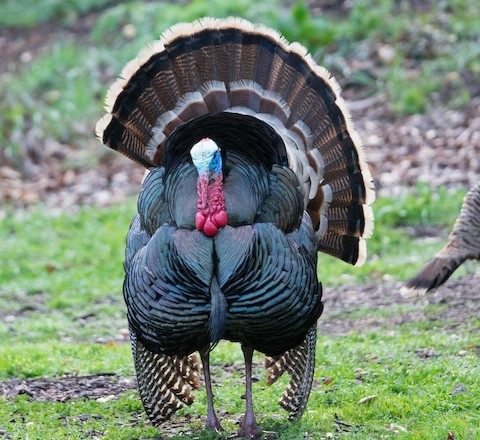
Wild Turkey, male displaying. (Coyote Hills Regional Park, Fremont, California; March 17, 2018.) © Mark Schulist
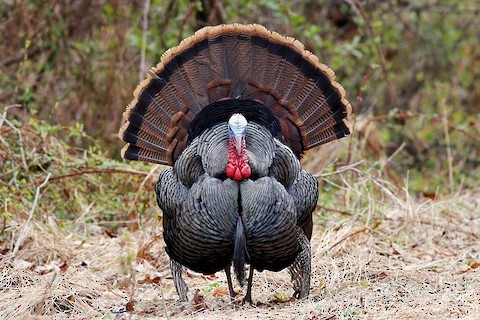
Wild Turkey, male displaying. (Pennypack Ecological Restoration Trust, Montgomery County, Pennsylvania; April 12, 2016.) © William Keim

Wild Turkey, female responding to displaying male—whose head appears mostly blue. (Bedford, Virginia; March 29, 2020.) © Bob Epperson

Wild Turkey, male displaying. (London, Ontario; March 31, 2018.) © Laure Wilson Neish
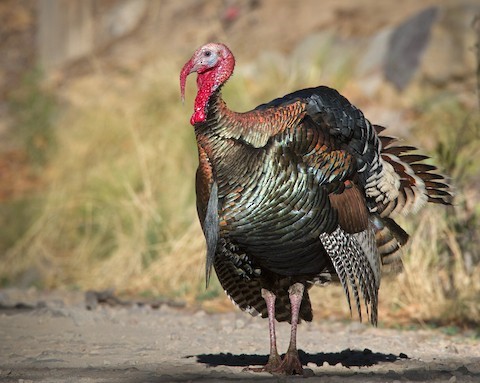
Wild Turkey, male at the end of a display. (Miller Canyon, Sierra Vista, Arizona; May 10, 2011.) © Lars Petersson

Wild Turkey. (Dartmouth, Massachusetts; March 12, 2017.) © Scott Martin

Wild Turkey, male. (Stony Creek Metropark, Macomb County, Michigan; February 16, 2019.) © Andrew Simon
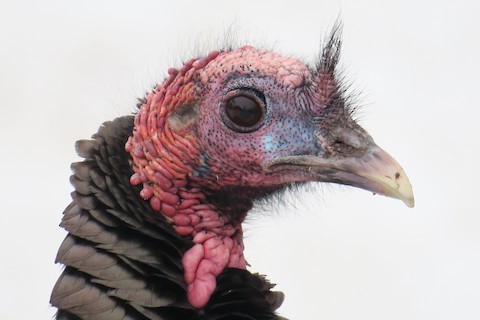
Wild Turkey, close-up of head showing texture of bare skin. (Wichita Mountains Wildlife Refuge, Comanche County, Oklahoma; December 27, 2017.) © Rishi Palit
When displaying, the male inflates protuberances on its head and neck.
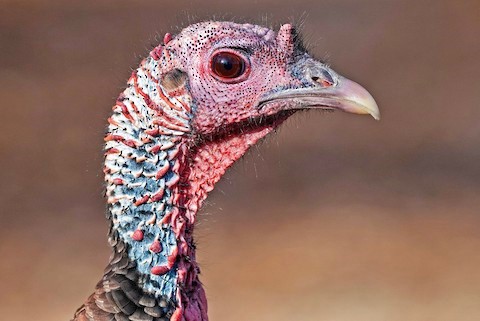
Wild Turkey, close-up of head showing texture of bare skin. (Kensington Metropark Nature Center, Oakland, Michigan; November 24, 2019.) © Andrew Simon
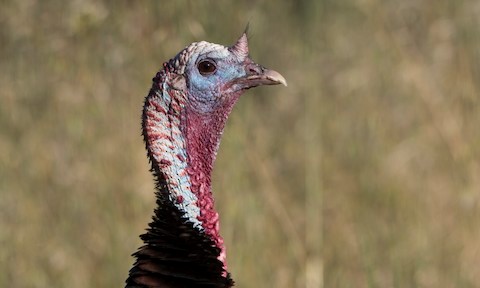
Wild Turkey, close-up of head showing texture of bare skin. (Carmel Valley, California; April 21, 2017.) © Brian Sullivan

Wild Turkey, close-up of male’s head with some distortion of features. (Davis Mountains Resort, Texas; June 6, 2019.) © Donna L. Dittmann

Wild Turkey, close-up of male’s head during display. (Stony Creek Metropark, Macomb County, Michigan; April 1, 2020.) © Andrew Simon
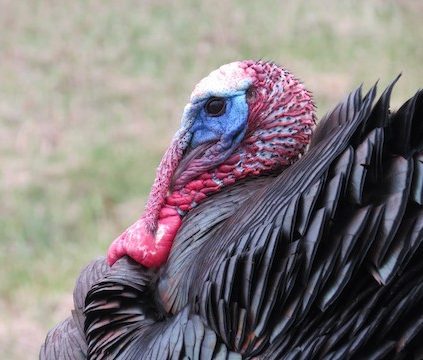
Wild Turkey, close-up of male’s head during display. (Parker River National Wildlife Refuge, Massachusetts; April 1, 2016.) © Marjorie Watson

Wild Turkey, close-up of head showing texture of bare skin. (Palo Duro Canyon State Park, Texas; June 15, 2018.) © cameralenswrangler

Wild Turkey. (Central Park, Bristol, Massachusetts; September 12, 2019.) © Joel Eckerson

Wild Turkey. (Central Park, New York, New York; April 22, 2017.) © D. Bruce Yolton
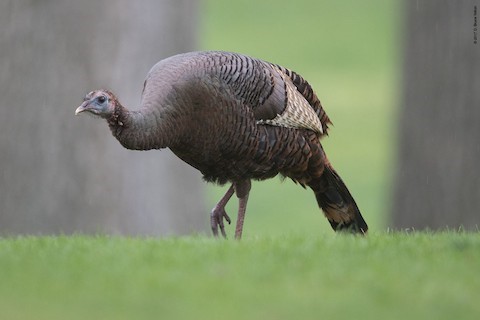
Wild Turkey. (Central Park, New York, New York; April 22, 2017.) © D. Bruce Yolton
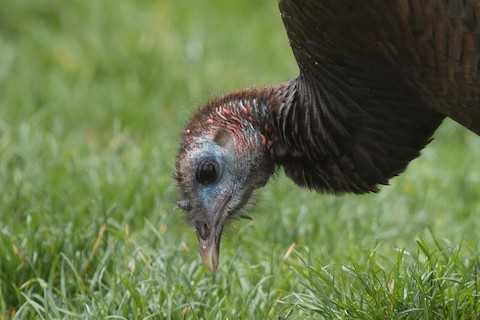
Wild Turkey. (Central Park, New York, New York; April 22, 2017.) © D. Bruce Yolton
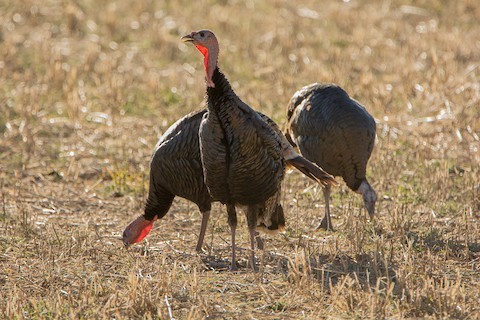
Wild Turkeys. (Bosque del Apache National Wildlife Refuge, New Mexico; November 3, 2017.) © Juan Miguel Artigas Azas
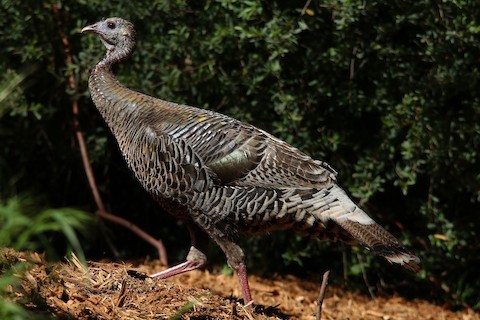
Wild Turkey. (Stow Lake, Golden Gate Park, San Francisco, California; April 17, 2018.) © Graeme Colmer
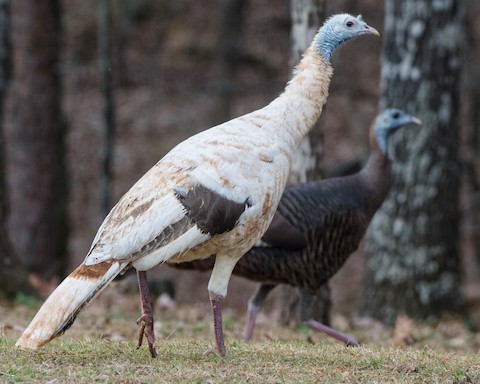
Wild Turkey, leucistic. (Big Rock, Arkansas; December 3, 2018.) © Susan Williamson

Wild Turkey, leucistic. (Chatham, Massachusetts; December 16, 2018.) © Liam Waters
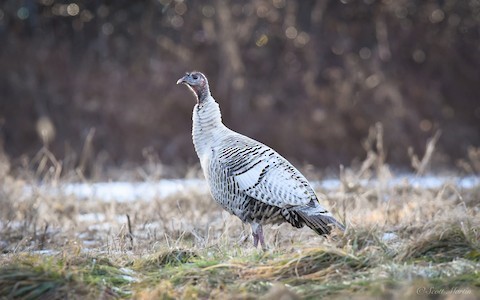
Wild Turkey, leucistic. (Minute Man National Historical Park, Concord, Massachusetts; January 24, 2018.) © Scott Martin

Wild Turkey in flight. (Cook Hnery Road, Chigger Ridge, Georgia; March 23, 2017.) © David Turko
Notes
Polytypic species consisting of six recognized subspecies.
Progenitor of the domestic turkey. The only species whose English name primarily differentiates it from livestock, and one of very few who share their name with a brand of liquor.
References
Alderfer, J., and J.L. Dunn. 2014. National Geographic Complete Birds of North America (Second Edition). National Geographic Society, Washington, D.C.
Atlas of Living Australia. 2020. Meleagris gallopavo: Wild Turkey. https://www.ala.org.au/. (Accessed April 24, 2020.)
BirdLife International. 2018. Meleagris gallopavo. The IUCN Red List of Threatened Species 2018: e.T22679525A132051953. https://dx.doi.org/10.2305/IUCN.UK.2018-2.RLTS.T22679525A132051953.en. (Accessed April 24, 2020.)
eBird. 2020. eBird: An online database of bird distribution and abundance. Cornell Lab of Ornithology, Ithaca, N.Y. http://www.ebird.org. (Accessed April 24, 2020.)
Howell, S.N.G., and S. Webb. 1995. A Guide to the Birds of Mexico and Northern Central America. Oxford University Press, Oxford.
Madge, S., and P.J.K. McGowan. 2002. Pheasants, Partridges, and Grouse: A Guide to the Pheasants, Partridges, Quails, Grouse, Guineafowl, Buttonquails, and Sandgrouse of the World. Princeton University Press, Princeton, N.J.
Porter, W.F., and G.M. Kirwan. 2020. Wild Turkey (Meleagris gallopavo). In: del Hoyo, J., Elliott, A., Sargatal, J., Christie, D.A. & de Juana, E. (eds.). Handbook of the Birds of the World Alive. Lynx Edicions, Barcelona. https://www.hbw.com/node/53318. (Accessed April 24, 2020.)
Xeno-Canto. 2020. Wild Turkey – Meleagris gallopavo. https://www.xeno-canto.org/species/Meleagris-gallopavo. (Accessed April 24, 2020.)

